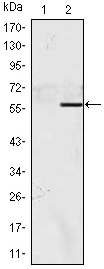NAC-1 Monoclonal Antibody
- Catalog No.:YM0463
- Applications:WB;IHC;IF;ELISA
- Reactivity:Human
- Target:
- NAC-1
- Gene Name:
- BTB14
- Protein Name:
- Nucleus accumbens-associated protein
- Human Gene Id:
- 112939
- Human Swiss Prot No:
- Q96RE7
- Mouse Swiss Prot No:
- Q7TSZ8
- Immunogen:
- Purified recombinant fragment of human NAC-1 expressed in E. Coli.
- Specificity:
- NAC-1 Monoclonal Antibody detects endogenous levels of NAC-1 protein.
- Formulation:
- Liquid in PBS containing 50% glycerol, 0.5% BSA and 0.02% sodium azide.
- Source:
- Monoclonal, Mouse
- Dilution:
- WB 1:500 - 1:2000. IHC 1:200 - 1:1000. ELISA: 1:10000.. IF 1:50-200
- Purification:
- Affinity purification
- Storage Stability:
- -15°C to -25°C/1 year(Do not lower than -25°C)
- Other Name:
- NACC1;BTBD14B;NAC1;Nucleus accumbens-associated protein 1;NAC-1;BTB/POZ domain-containing protein 14B
- Molecular Weight(Da):
- 57kD
- References:
- 1. Neuroscience. 2002;110(3):421-9.
2. Proc Natl Acad Sci U S A. 2004 Aug 17;101(33):12130-5.
- Background:
- This gene encodes a member of the BTB/POZ protein family. BTB/POZ proteins are involved in several cellular processes including proliferation, apoptosis and transcription regulation. The encoded protein is a transcriptional repressor that plays a role in stem cell self-renewal and pluripotency maintenance. The encoded protein also suppresses transcription of the candidate tumor suppressor Gadd45GIP1, and expression of this gene may play a role in the progression of multiple types of cancer. A pseudogene of this gene is located on the short arm of chromosome 9. [provided by RefSeq, Feb 2012],
- Function:
- function:Functions as a transcriptional repressor. Seems to function as a transcriptional corepressor in neuronal cells through recruitment of HDAC3 and HDAC4. Contributes to tumor progression, and tumor cell proliferation and survival. This may be mediated at least in part through repressing transcriptional activity of GADD45GIP1. Required for recruiting the proteasome from the nucleus to the cytoplasm and dendritic spines.,similarity:Contains 1 BTB (POZ) domain.,subcellular location:Distribution in the cytoplasm is dependent on phosphorylation.,subunit:Homooligomer; mediated by the BTB domain. Interacts with HDAC3 and HDAC4. Interacts (via BTB domain) with CUL3, PSMD7 AND RCOR1.,tissue specificity:Overexpressed in several types of carcinomas including ovarian serous carcinomas. Expression levels positively correlate with tumor recurrence in ovarian serous carcinomas, and intense immuno
- Subcellular Location:
- Nucleus. Cytoplasm. Distribution in the cytoplasm is dependent on phosphorylation. .
- Expression:
- Overexpressed in several types of carcinomas including ovarian serous carcinomas. Expression levels positively correlate with tumor recurrence in ovarian serous carcinomas, and intense immunoreactivity in primary ovarian tumors predicts early recurrence. Up-regulated in ovarian carcinomas after chemotherapy, suggesting a role in development of chemotherapy resistance in ovarian cancer.
- June 19-2018
- WESTERN IMMUNOBLOTTING PROTOCOL
- June 19-2018
- IMMUNOHISTOCHEMISTRY-PARAFFIN PROTOCOL
- June 19-2018
- IMMUNOFLUORESCENCE PROTOCOL
- September 08-2020
- FLOW-CYTOMEYRT-PROTOCOL
- May 20-2022
- Cell-Based ELISA│解您多样本WB检测之困扰
- July 13-2018
- CELL-BASED-ELISA-PROTOCOL-FOR-ACETYL-PROTEIN
- July 13-2018
- CELL-BASED-ELISA-PROTOCOL-FOR-PHOSPHO-PROTEIN
- July 13-2018
- Antibody-FAQs
- Products Images

- Western Blot analysis using NAC-1 Monoclonal Antibody against HEK293 (1) and NACC1-hIgGFc transfected HEK293 (2) cell lysate.

- Immunohistochemistry analysis of paraffin-embedded mammary cancer tissues (left) and ovarian cancer tissues (right) with DAB staining using NAC-1 Monoclonal Antibody.



